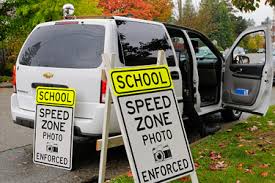Installing fixed cameras to enforce school zone speed limits of 20 mph has proved to be a huge boon to the city’s coffers.
A report by the Seattle Police Department released earlier this week shows that a total of 24,339 tickets (at $189 a crack) were issued by cameras set up at four elementary schools between Dec. 10, 2012 and April 27, 2013. That’s an average of more than 300 tickets a day for every day the four schools were in session. This compares to 20,135 moving violations meted out by Seattle police for the entire year of 2012.
“I think this is having a chilling effect,” Council member and mayoral candidate Bruce Harrell told Seattle Weekly today. “I think we need to see whether crossing guards are a more effective way in dealing with this. Maybe we should be using some of the money (collected in fines) for crossing guards.” Harrell added that the $189 price tag is too steep and that a lower cost for the infraction would still serve as a deterrent.
So costly after the fines, in fact, that the police report noted that nearly 24 percent of those motorists who have received tickets have requested mitigation hearings before a Municipal Court magistrate.
The pilot project, which will almost certainly lead to more school cameras – five more schools have been proposed — netted the city more than $2.7 million during that four-month period. “I’m sure it will hit $5 million by the end of the year,” enthused Councilman Tom Rasmussen, who chairs the Public Safety and Transportation Committee.
By contrast, parking tickets, of which nearly 540,000 were written last year by Seattle’s 103 parking enforcement officers – once known not-so-affectionately as meter maids) – fetched the city a cool $25 million. (Seattle Weekly will publish an extensive story on the city’s parking problems next Wednesday.)
The crackdown began Nov. 1, 2012, but with only advisory warnings given to drivers caught speeding in the 20 mph zone at Broadview Thompson, Gatewood Elementary, Olympic View Elementary and Thurgood Marshall Elementary.
At the time, they city also distributed more than 2,000 flyers, translated into seven language, informing motorists of the impending photo enforcement when the lights are flashing in the school zone.
The police report stressed that “drivers are not cited at 21 mph, but rather at a violation trigger speed (VTS) that allows some cushion to accommodate slight variations om speedometer readings or other potential technical issues.” Whatever the hell that means.
According to the report, speeding drivers in school zones have been reduced 16 percent.
“Yeah, $189 is a pretty big ticket, but we are trying to save life,” says Rasmussen. “We can’t just give them a slap on the wrist if they are, saying, going 40 miles an hour in a school zone.”
Public safety or cash cow? You decide.








